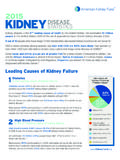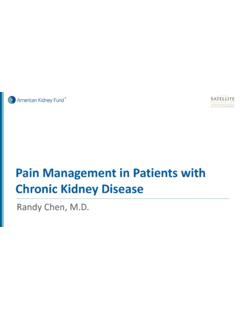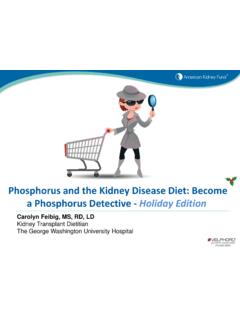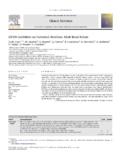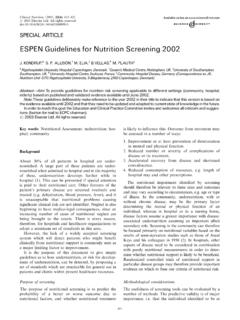Transcription of What CAN I Eat? Nutrition for Dialysis Patients
1 What CAN I Eat? Nutrition for Dialysis PatientsJaneen Leon, MS, RDN, LD Case Western Reserve UniversityTuesday, June 14, 2016 Janeen Leon, MS, RDN, LD Clinical dietitian, researcher, program evaluator at the MetroHealthMedical Center, Cleveland, OH Adjunct Instructor of Medicine at the Case Western Reserve University School of Medicine. Recipient of this year s Joel D. Kopple Award for her research and Nutrition education on phosphorus additivesThank you to our speaker!In this webinar we will proteinis required for Dialysis ? How can we meet this protein requirement?
2 2. What is the difference between phosphorus and potassium? What can be safely eaten to manage these?3. How to manage fluid balance through careful sodium (salt) and fluid useGood Nutrition Avoids malnutrition and preserves or achieves healthy body weight Promotes healthy body functions, reducing risks of uncontrolled diabetes, high blood pressure, heart disease, etc. Prevents mineral and electrolyte abnormalities Promotes better immunity ability to fight infectionsGood NutritionStarts at the grocery store or restaurantGood NutritionAnd ends at the plate in front of youFood is Derived from Basic Nutrition ComponentsMacronutrients Major Nutrients Protein poultry, meat, fish, eggs, dairy soy, vegetables, grains Carbohydrates starches, sugars, fiber vegetables, fruits.
3 Grains Fat animal and plant basedBasic Nutrition ComponentsMicronutrients Little Nutrientsessential to the body many roles jobs Vitamins B (many), C, D, E, K Minerals potassium, phosphorus, calcium, sodium, ironWhat Can I Eat? proteinis required for Dialysis ? How can we meet this protein requirement?2. What is the difference between phosphorus and potassium? What can be safely eaten to manage these?3. Learn how to manage fluid balance through careful sodium (salt) and fluid useProtein Building blocks to heal, regenerate, preserve Needs are higher than usual because of Dialysis losses Amount required is primarily based on body weight Discuss with your renal dietitian, especially if over-or underweightProtein How Much Each Day?
4 = g protein/kg for hemodialysis = g protein/kg for peritoneal dialysis75 kg (165 lb) person x g/kg = 90 g protein/day or about 8 ounces of meat/fish/poultry/eggs per dayMost people need between 6-10 ounces high protein foods each day. 8 Ounces is Half A Pound! That Sounds Like a Lot!Break it Down -21 grams or a 3 ounce portion = size of a deck of cards or the palm of your hand for Meat/poultry/seafood/fish14 grams = 2 eggs2 eggs = 14 grams7 grams = 1 ounce low fat cheese4 grams = cup milk or yogurt (one per day)Make it Work for You!
5 Dialysis gets in the way of breakfast? Have 4 ounces meat/fish/poultry at both lunch and dinnerORYou d rather have a big breakfast and skip lunch? Fine! Have 2 eggs (2 oz) and a mid-sized homemade turkey sausage patty for breakfast (2 ounces) and 4 ozfish/poultry/meat for dinnerMake it Work for You! Prefer to graze? 1 egg breakfast 1 slice low sodium Swiss cheese for morning snack 2 ounce low sodium deli turkey for lunch 1 deviled egg for afternoon snack 3 oztrout for dinner Divide it up the way that fits your life and appetite best! Discuss with your dietitian so you know how to best distribute your phosphate CarefullyIn this webinar we will proteinis required for Dialysis ?
6 How can we meet this protein requirement?2. What is the difference between phosphorus and potassium? What can be safely eaten to manage these?3. Learn how to manage fluid balance through careful sodium (salt) and fluid usePhosphorus Affects boneand heartdisease risk Naturally in many foods (limit these!) Added as ingredient in many processed foods (avoid these!)Potassium Affects electrical conductivity in heart Naturally in many foods (limit these!) Added as ingredient in some processed foods (avoid these!)2000 mg/day limit The P Words CONFUSING!
7 ?!800 mg/day limit Phosphorus Naturally in animal foods (eggs, dairy, meat/poultry/fish) & whole grains Added to chicken, seafood, frozen foods, baked goods, drinks, saucesPotassium Naturally in dairy, meat/poultry/fish, dried beans, potatoes, some fruits/vegetables Added to low sodium foods, especially soups, broths and to some juices, P Words CONFUSING!?!Phosphorus Look for PHOS in ingredient label to find Not required to be listed on Nutrition facts Look on Nutrition facts label. Is required starting July 2018. Know which foods to avoid.
8 Carefully read ingredient lists for low sodium P Words Where!?!Lower Potassium VegetablesLettuceCeleryCucumberCarrotsBe ll peppersRadishZucchiniYellow squashRaw spinachCauliflowerCornCabbageMushroomsEg gplantOnionsGarlicGreen beansAsparagusSnow pea podsLow Potassium Vegetables Aim for 3-4 servings a day (1/2 cup cooked or 1 cup raw) Enjoy a variety of ways Raw, Steamed, Microwaved, Broiled, Baked, Pan-Fried Toss with homemade Italian dressing and grill Toss with oil and herbs and roast Stir fry with a little sesame oil, ginger, broth or wine, pinch of sugar and lemon juice Fresh squeeze of lemon or lime juiceLow Potassium Fruits Aim for 2-3 servings a day (1/2 cup canned or 1 medium piece Enjoy a variety of ways Raw, Canned, Frozen Dip in cream cheese blended with fresh fruit Make into a crisp ( apple crisp))
9 Dip in whipped cream Make into small smoothie, add scoop of whey proteinLower Potassium FruitsApplePearStrawberriesBlueberriesCr anberriesMandarin OrangesGrapesBlackberriesRaspberriesTang erine/HaloWatermelon (1 cup!)Fruit cocktailApplesauceSmall peach/nectarinePineappleCherriesPlumIn this webinar we will proteinis required for Dialysis ? How can we meet this protein requirement?2. What is the difference between phosphorus and potassium? What can be safely eaten to manage these?3. Learn how to manage fluid balance through careful sodium (salt) and fluid useSodium and FluidHeavily influence one limit to 1500-2000 mg/day.
10 Salt is made up of sodium. 1 measuring teaspoon of salt has 2300 mg sodium Read food labels. Caution with low sodium read for potassium Sodium is often in foods that do not taste salty bread, unseasoned meat Basil Oregano Garlic Chives Sage Thyme Rosemary Cilantro Mint Parsley Squeeze of lemon or lime brightens flavors Peppers jalapeno and othersSeasoning Without SaltGenerous use of fresh & dried herbs grow your own!Fluid Accumulates in your body between treatments Typically limit to 4 cups a day if 3 times a week Dialysis . Less restrictive if peritoneal or daily home Dialysis (maybe no restrictions).



